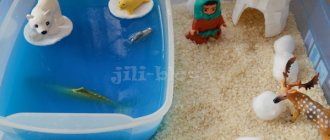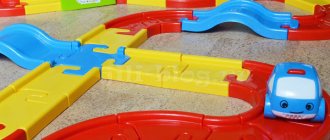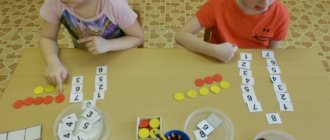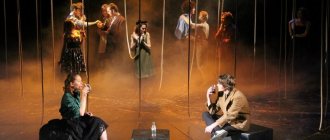Fun activities for children aged 2-5 years. Music classes
By nature, every child is musical. It is difficult to imagine a more favorable period for the development of musical abilities than childhood.
Musical and didactic games help develop the ability to listen to music, distinguish pitch, timbre, dynamics and duration of sound, develop independent musical activity, and help consolidate children’s knowledge of musical instruments.
Children's music playing expands the scope of a child's musical activity, increases interest in musical activities, promotes the development of musical memory and attention, helps overcome stiffness and shyness, and expands musical education.
During the game, children display the individual characteristics of the performer: the presence of will, emotionality, concentration, creative and musical abilities develop and improve.
Loudly - quietly binge drinking
Game material
Any toy.
Progress of the lesson
Several people can take part in the game. They can be the baby's relatives or his friends.
A driver is selected and leaves the room. The rest agree on where to hide the toy.
The driver’s task is to find it, guided by the sound of the song, which can be sung by all participants or one of the players. Everyone needs to remember the basic rule: the sound of the song increases as you approach the place where the toy is located, or weakens as you move away from it.
If the child has completed the task, then another driver is selected, and this child hides the toy when the game is repeated.
Noise and rustle
(Development by S. S. Klimova)
Game material
Rustling objects (you can choose any that you have at home), for example:
— fabric rattles with crunchy and rustling elements sewn in;
- paper;
- rain stick;
- plastic bag
Progress of the lesson
You can do it in silence, or with music, for example, “Noise and Rustle” by E. Poplyanova.
Place all items under the material (hidden from the child).
The child is sitting nearby. An adult takes turns taking out objects and showing how this or that object rustles. After your show, you should definitely give it to the child so that he can play and rustle.
Then the song starts. During the song, the child rustles with one object at first, with a second object when turned on again, etc. When last turned on by all items.
Fairy tale Teremok with musical and/or noise instruments
Game material
Each character in a fairy tale needs an instrument or rattle to voice it. Below is an example of what musical and noise instruments you can use, but you can use absolutely anything you have on hand.
Example of tools:
- mouse-norushka - any bath toy that squeaks or a metallophone in the upper case;
- frog-croak - castanets or wooden spoons or wooden frog - guiro;
- runaway bunny - maracas or shakers;
- little fox-sister - medium register metallophone or xylophone;
- top-gray barrel - tambourine or tambourine;
- clubfoot bear - drum.
You can also use a rain stick - for example, adding that it is raining or a pan flute, a harmonica - the wind, etc. It all depends on your imagination.
Fairy tale
There is a tower in a field. A small mouse runs past. She saw the tower, stopped and asked:
- Terem-teremok! Who lives in the mansion? (the child plays the instrument, pretends to be a mouse).
Nobody responds. The mouse entered the little mansion and began to live there.
A frog-frog galloped up to the mansion and asked:
- Terem-teremok! Who lives in the mansion? (the child plays the instrument, pretends to be a frog).
- I, little mouse! And who are you? (the child plays the instrument, pretends to be a mouse).
- And I am a frog-croak (the child plays the instrument, imitates a frog).
- Come live with me! The frog jumped into the tower. The two of them began to live together.
A runaway bunny runs past. He stopped and asked:
- Terem-teremok! Who lives in the mansion? (child plays an instrument, pretends to be a hare)
- I, little mouse! (child plays an instrument, pretends to be a mouse)
- I, frog-frog! And who are you? (child plays an instrument, pretends to be a frog)
— And I’m a running bunny (the child plays the instrument, pretends to be a hare)
- Come live with us! The hare hops into the tower! The three of them began to live together.
A little fox-sister walks by. She knocked on the window and asked:
- Terem-teremok! Who lives in the mansion? (child plays an instrument, pretends to be a fox)
- I, little mouse (the child plays the instrument, pretends to be a mouse)
— I, the frog-croak (the child plays the instrument, pretends to be a frog)
- Me, the runaway bunny. And who are you? (child plays an instrument, pretends to be a hare)
- And I am a little fox-sister (the child plays the instrument, pretends to be a fox)
- Come live with us! The fox climbed into the mansion. The four of them began to live together.
A gray barrel top came running, looked in the door and asked:
- Terem-teremok! Who lives in the mansion? (child plays an instrument, pretends to be a wolf)
- I, little mouse (the child plays the instrument, pretends to be a mouse)
— I, the frog-croak (the child plays the instrument, pretends to be a frog)
— I, the running bunny (the child plays the instrument, pretends to be a hare)
- Me, little fox-sister. And who are you? (child plays an instrument, pretends to be a fox)
- And I am a top-gray barrel (the child plays the instrument, pretends to be a wolf)
- Come live with us!
The wolf climbed into the mansion. The five of them began to live together. Here they live in a little house, sing songs.
Suddenly a clubfoot bear walks by. The bear saw the tower, heard the songs, stopped and roared at the top of his lungs:
- Terem-teremok! Who lives in the mansion? (child plays an instrument, pretends to be a bear)
- I, little mouse (the child plays the instrument, pretends to be a mouse)
— I, the frog-croak (the child plays the instrument, pretends to be a frog)
— I, the running bunny (the child plays the instrument, pretends to be a hare)
— I, little fox-sister (the child plays the instrument, pretends to be a fox)
- I, the top-gray barrel. And who are you? (child plays an instrument, pretends to be a wolf)
- And I’m a clubfooted bear (the child plays the instrument, pretends to be a bear)
- Come live with us!
The bear climbed into the tower. He climbed and climbed and climbed and climbed - he just couldn’t get in and said:
- I’d rather live on your roof (child plays an instrument, pretends to be a bear)
The bear climbed onto the roof and just sat down, the tower crackled and fell apart.
We barely managed to jump out of it:
- little mouse (the child plays the instrument, pretends to be a mouse),
— frog-croak (the child plays the instrument, pretends to be a frog),
— runaway bunny (the child plays the instrument, pretends to be a hare),
— little fox-sister (the child plays the instrument, pretends to be a fox),
— a top-gray barrel (the child plays the instrument, pretends to be a wolf)
- everyone is safe and sound.
They began to carry logs, saw boards, and build a new mansion.
They built it better than before!
Games - exercises with musical instruments for children 3-4 years old
Games - exercises with musical instruments for children of the younger group
Author: Svetlana Nikolaevna Kryuchkova, music director of MDOU kindergarten No. 127 “Northern Fairy Tale”, Petrozavodsk Purpose: the material is designed for children 3-4 years old (junior group 2), can be useful for musical leaders and educators. Exercise games with musical instruments can be included as part of entertainment, or in any activity with children. Goal: development of children's creative abilities Objectives: - teach techniques for playing musical instruments - develop creative imagination - develop rhythmic hearing
“In the morning the sun will wake up”
(exercise with spoons) For the musical accompaniment of the game, you can use any Russian folk melody, for example “Oh, you canopy”, “The month is shining”...). Presenter: (shows the sun)
There is a sun around, my friend, quickly stand in a circle.
(children stand in a circle, the sun can be placed in the middle of the circle. Wooden spoons are laid out on the floor in a circle according to the number of children (2 spoons for each child) Presenter: Guys, the sun has prepared spoons for us and wants us to play for him. The children squat down about his pair of spoons. The teacher or music director says the text, the children listen. Then, to the music, the children rhythmically play on the spoons. Presenter: 1. In the morning the sun will wake up, He will immediately smile at the children. The children with the sun get up and take the spoons in their hands. To the music, the children slowly rise, take the spoons in their hands. 2. The children took the spoons in their hands, They knocked on the spoons together. They hit the spoon against the spoon in front of them 3. We are now going to light the oven - We need to bake pancakes. Slightly tilting the body with the spoons to the right, the left hand with the spoon on top, then too to the very left - “baking pancakes” 4. It’s time for us to have some fun, Ride in carousels. They spin around themselves with a stomping step, play on spoons, hold them in front of them 5. We are with you now, guys, Let’s play hide and seek together. We hit the spoons in front of us to the downbeat of the music, then we move our hands behind our backs and hit the spoons behind our backs 6. We will go up the hill, and then go down the mountain. Gradually raising straight arms up, quickly hitting with spoons, then lowering our hands down, hitting with spoons 7. Our spoons were so tired, They danced very happily. We'll put it on half a spoon and put our palms together. We'll rest a little, and then we'll start dancing again. The children are squatting, hands under their cheeks - resting.
How we danced merrily, banging spoons together. The sun is smiling, which means he likes it.
"Musicians".
(for exercise games you can use a puppet theater or toys) Each character brings with him a basket with musical instruments according to the number of children
1. Petya the Cockerel is coming. He is carrying a basket. And in the basket there are toys, naughty rattles. The rattles will ring and everyone around will have fun. (to any cheerful music, hit your palm with a rattle)
2. The fox came running to us and showed us the sticks. We'll go up to the fox and take the sticks in our hands. We hit with sticks and have a lot of fun playing. (knock with chopsticks to the music) 3. The chicken came to visit, She brought Maracas, We’ll go to the chicken, We’ll take the Maracas. We'll take the maracas and shake them together. (we shake maracas to the music - you can use large Kinder Surprise eggs, filling them with cereal)
The musicians are good, everyone played from the heart. Get all your palms ready, clap for us a little.
We recommend watching:
Water games for the second younger group. Card index Fun game “Roosters” for the younger group Nursery rhyme “Chicks” for games with children of the younger group Musical games for the younger group of kindergarten
Similar articles:
What are educational games for preschoolers
Games to develop attention for children 3-4 years old in kindergarten in a group
Didactic games in the younger group. Card index
Playing with sand in the younger group
Musical development of young children
Music for babies: we sing nursery rhymes and lullabies to the baby
Psychologists in perinatal (i.e. prenatal) education claim that the child hears the voices of his parents and music while still in the womb. And after birth, the baby is able to distinguish between high and loud sounds. The baby reacts to his mother’s voice and calms down from its sound. And you can safely begin your child’s musical education right in the maternity hospital. When you change his clothes or swaddle him, feed him or rock him to sleep, sing songs of any content to your baby. For example, these.
***
Chuk, chuk, chuk-chuk, On the mountain there are little pods, Under the mountain there are shovels, little boys are running.
***
Give me your hands, get up from the bed, let's go wash up, where we can find some water!
***
Stretch-pull-ears, From socks to top-ears, We will stretch and stretch, We will not remain small, we will not remain small.
How to tell about notes?
Before you introduce your child to notes, you need to explain to him what they are.
Notes are recorded sounds. Just as we write our speech in letters, so music is written in notes. There are a huge variety of notes: both high and low, but they are all divided into 7 basic ones, which everyone knows: do, re, mi, fa, salt, la, si.
The notes live on a musical staff, which consists of 5 lines. The notes can be located either directly on these lines, or between them, they can also be under and above the lines, and on additional lines that we draw above or below.
Draw a staff of music on a large sheet of paper and write notes in a row on it (you can color them in different colors). Then sing them all together with your child.
To make your child interested in learning notes, you can show him a cartoon about the notes “Do Re Mi.”
A start has been made - the child has a general understanding of notes. Only after showing interest in notes can you start learning them seriously (it’s better to do this on another day).
How to remember notes and their location on the staff?
First, let's prepare everything we need:
- draw a large musical staff on a piece of paper;
- Let's cut out 7 oval notes the size of a 5-ruble coin.
It is advisable that the notes be colored, like the colors of the rainbow: this way they are better remembered.
Training should take place in several stages:
- First, we learn three notes located on the first three lines: mi, salt, si.
- When the child learns three notes and can identify them in different sequences, we begin to study the notes located between the lines: D, F, A.
- When the child masters both of them and is able to identify both interspersed, we learn the note “C” located on the additional line, and the “C” of the 2nd octave between the third and fourth line.
- After this, ask your child to make a scale of notes, starting with “C” of the 1st octave and ending with “C” of the 2nd octave.
- At the next stage, the child lays out simple melodies from notes, writes them out in an album and performs them on the piano. This stage is especially pleasant for him, because he plays the notes!
- After this, you can safely take children's music books and identify the notes there.
When the child already identifies all the notes well, you can move on to gradually learning everything else: keys, durations, pauses, octaves, etc.







